Original URL: https://www.theregister.com/2013/11/01/could_doctor_who_really_bump_into_human_space_dwellers/
Could Doctor Who really bump into human space dwellers?
There are a few things we'll need to sort out first
Posted in Science, 1st November 2013 17:00 GMT
Doctor Who @ 50 “Oh, you might have spent a million years evolving into clouds of gas... and another million as downloads, but you always revert to the same basic shape: the fundamental human. End of the universe and here you are. Indomitable, that's the word! Indomitable! Ha!” - the Tenth Doctor.
Much discussion is given over to the timey-wimeyness of Doctor Who, but not so much to the Tardis’ ability to zip through space as well as it does through time.
In the Doctor Who future humans colonise space and live happily on distant planets (New Earth) and in space stations (The End of the World), travelling the galaxy aboard all kinds of ships (42) and even sitting on the edge of black holes (The Impossible Planet). Doctor Who has presented many different potential habitats for folk to live in and ways for them to get off the third rock from the Sun.
But just how close is the science fiction to the science fact, and what would it take to work, travel and live in space?
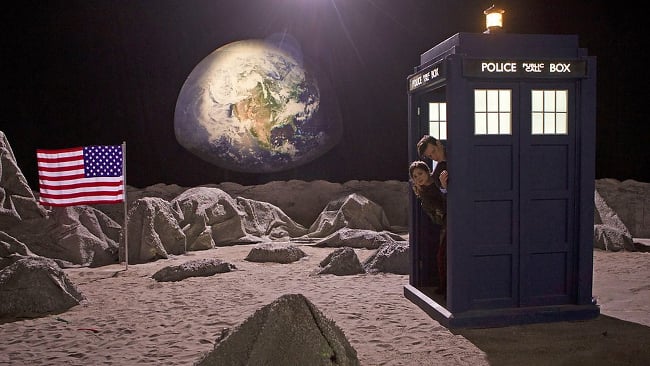
Source: BBC
In real life, the race is somewhat on to put the people outside the reach of Earth's pull, on Mars. Former rocket scientist and the world’s first private space tourist, Dennis Tito, has come up with a mission to get two people on a round trip to the Red Planet in just five years’ time. The pair, likely a married couple, won’t get to land, but they are aiming to survive the trip.
For his part, famous internet zillionaire and rocket kingpin Elon Musk wants to establish a colony of 80,000 people living and working on the red planet.
There’s also Mars One, a not-for-profit foundation that wants to establish a permanent human settlement on Mars in 2023. There are no billionaires in this push, so they figure they can do it by getting volunteer astronauts to audition, train and go through with the mission on TV to fund the trip.
But why limit ourselves to planets? This hardly begins to touch on the potential for freespace structures - platforms, stations or whatever you want to call them - that will spin or float or sit on the edge of gravity wells to form fully man-made places for humans to live.
For this, you need fuel and materials to get started and move about - and that's where firms like Deep Space Industries (DSI) are hoping to come in. DSI plans to start mining asteroids for metals and materials that would be useful not just back here on Earth, but to those who are hoping to journey on and to build new worlds for themselves in space.
The reasoning is that hauling materials up from Earth to develop and sustain operations would be too expensive and slow, so DSI would build a waystation in free space on the cosmic highway towards other space stations, planets or moons.
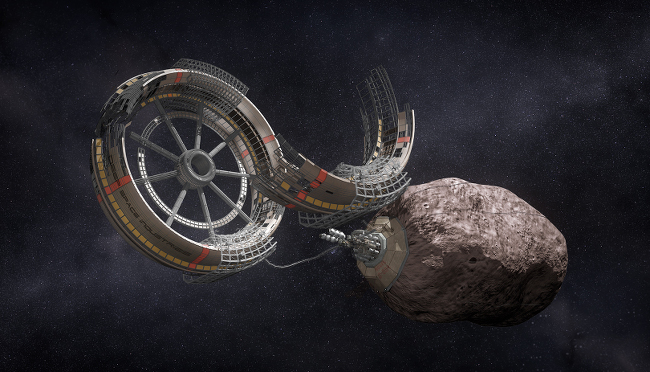
The gas station at the end of the universe. Credit: DSI
"One of our analogies to investors was an interchange on a big motorway," DSI chairman Rick Tumlinson told The Register. "It's as if it's the interchange where you go there to Mars, that way is the Moon, that way is on beyond and we're at that interchange.
"And we're going to drop a big oil well down and we're going to create a gas station and refine the oil, and [have] a restaurant and an oasis and a building supply store - that's what we're going to be doing using asteroid materials."
Big sky thinking, but the devil is in the details. Never mind the difficulty of actually building that gas station complex, getting men and material in location in the first place is going to be hard enough. DSI and its rival space mining firm Planetary Resources are still in the planning stages of how they would even get out there and land on asteroids, not to mention mining them for the raw materials our own planet is running out of.
Among the challenges, and in no particular order: there's the need for spaceships that can get you out there and back safely, the small issue of food, water and waste disposal for the crews, the unknown psychological and physical impacts of space and planet-dwelling on workers, and - oh yeah - the fact those going into space must survive the omnipresent background radiation found in space beyond the Van Allen belts that will likely saturate and kill them before too long.
"All of time and space; everywhere and anywhere; every star that ever was. Where do you want to start?"
Virgin Galactic chief exec George Whitesides reckons the first hurdle just happens to be one his company is helping to work on - rocketships.
"The number one thing that we need to be working on is reusable access to space and the reason for that is that makes everything cheaper," he said.
"Basically, propulsion technologies that are suitable for putting things into orbit many times in a row rather than throwing it away after every flight, which is sort of what we do now - which is like throwing away a 747 every time we cross the Atlantic."
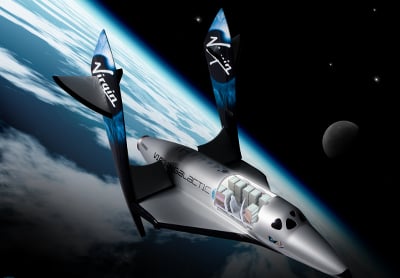
Artist's concept of Virgin Galactic SpaceShipTwo. Credit: Virgin Galactic
"And that entails a whole range of different things like reusable engines, highly reusable materials that can be used for thermal protection systems and high efficiency rocket propulsion techniques. Or any kind of propulsion actually - it could be a combination of things where you could use a scramjet or a ramjet as a sort of intermediary stage for the rocket engine," he added.
Whitesides and Virgin Galactic don't, of course, have even so much as a basic ramjet on hand - let alone a tricky scramjet. Their "SpaceShipTwo" rocket planes will take off carried by conventional jet "motherships", which will release them at high altitude where they will fire up their rockets to achieve great heights. But the Virgin ships are not really space ships at all: they won't be able to achieve orbit. They aren't going to get anyone even to a space station, let alone to Mars or worlds still further away.
So what might get us out into space for real?
There are a number of ways that realspace ships could be powered: these include chemical rockets, ion thrusters that use electromagnetism to accelerate charged particles and solar sails. These are all capable of travel within the Solar System, though we're talking about journey times lasting years in most cases. One exception is the VASIMR plasma drive, which could get people to Mars in just a month - though it would need to be powered by a hefty nuclear powerplant rather than feeble solar cells to achieve this.
Beyond this, we're starting to get into science fiction. This includes pulsed plasma - most likely generated by exploding nuclear weapons behind the craft so it can ride the shockwaves - fusion rockets and such like. These might permit humans to get around our own solar system on practical timescales with practical amounts of radiation protection, and they don't violate the laws of physics: though they might violate the laws of politics and economics.
To get to other solar systems on human timescales, we'll need some kind of warp or hyper drive.
Assume propulsion has been sorted out, crew and craft would also need protection from radiation. Tito's Martian mission is looking for a couple over childbearing age for that very reason, to at least mitigate some of the potential issues from exposure. But even still, "unless you're really willing to go to Mars and die five years later, you have to have some sort of protection", Tumlinson said.
Current manned missions stay well inside the Van Allen radiation belts, the two doughnut-shaped regions of high-energy electrons and ions trapped in the Earth's magnetic field that protect the planet and its inhabitants. Full-on space travel would mean leaving this region and dealing not only with general background cosmic radiation but also with solar flares.
The only missions ever to leave the Van Allens' protection so far were the Apollo missions to the Moon, which made only brief and carefully-timed excursions into danger. A serious solar event during an Apollo mission could have seen the astronauts suffer major or even fatal radiation doses.
The thorny problem is that the the shielding that would be required to keep people safe in space is so massive, the ships wouldn't have the propulsion to get off the ground. One study by researchers at the University of Rochester Medical Center showed that not only would prolonged exposure to space radiation increase cancer risk, and cause cardiovascular problems and musculoskeletal issues, it would also lead to degeneration of the brain. One of the researchers, Dr Michael O'Banion, said that to protect against the worst of the radiation "one would have to essentially wrap a spacecraft in a six-foot block of lead or concrete".
So if humans want to travel through deep space, boffins will need to come up with some new process or material that can help. Whitesides points out that some scientists are working on the idea of surrounding the craft with large volumes of water as a form of shield, while others are looking at using a nuclear reactor to create a forcefield.
But even if a perfect solution isn't found, people may still be willing to go ahead for the chance to be among the first in space.
Just an aspect of risk
"If we can mitigate it sufficiently, it could become almost just an aspect of risk. If you're increasing the risk of cancer by one per cent or something like that, that may be an acceptable risk to certain professions - certainly we have other professions that deal with workforce risk," suggests Whitesides.
Tumlinson suggests the best protection would come from living under the Martian soil rather than from shielded structures on the surface or in space.
"There is an illusion that because we live on the surface of the Earth that people are going to go build cities on the surface of Mars or the Moon," Tumlinson said, "it's absolutely incorrect."
"If you go to Mars, you're going to be living under Mars not on Mars. At least until they come up with some magic Star Trek-like space screen generator thing, which is not out of the question - look at all the other things that we never thought would come out of Star Trek that we have now! But until then, we're going to have live underneath the surface to protect us from radiation."
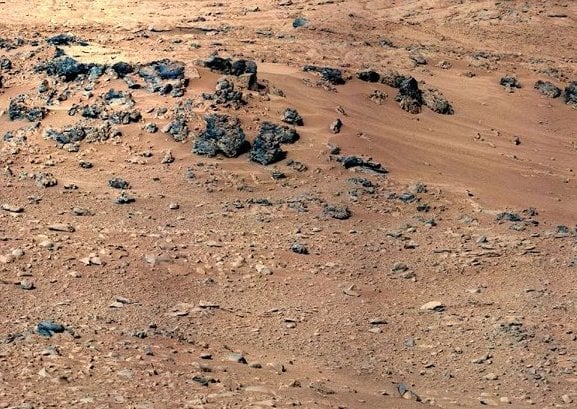
This is what a real Martian settlement might look like. Credit: NASA/JPL-Caltech/MSSS
"We're biased towards a place that has a sky and the mythology that goes with Mars. We're planetary surface-dwelling creatures and we like big open skies, even if most of us don't live anywhere we can even see the sky most of the time. But it's a romantic notion so Mars will probably be where you begin to see some of the first development of permanent civilisation," Tumlinson said.
With somewhere safe underground on the Red Planet to go to, the key for the ships would become to make the journey as fast as possible, trading off between the length of exposure and the weight of the rocket.
"Always take a banana to a party, Rose: bananas are good!"
Assuming shielding is sorted, the next big considerations would be food and water and somewhere to put waste.
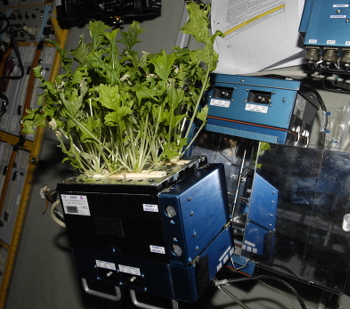
Mizuna lettuce being grown on the ISS. Credit: NASA
Experiments on growing food in space have been taking place aboard the ISS since 2002 - the space station has what it calls a "green house" that's been used to conduct 20 experiments. Test have been conducted to establish what crops can be grown and consumed safely in space, what micro-organisims grow on the plants, how to clean plants after harvesting and what techniques are best suited to growing plants in conditions with small amounts of gravity. This has included looking at different rooting materials with different rates of fertiliser release. Among the crops grown before being harvested and frozen for the return trip to Earth was Mizuna lettuce.
Growing food is important for more than simple nutrition - it's got a practical objective, too. Once people start heading out on trips that are going to last longer than a year, they'll stop being able to fit all the food they need in the tin can with them. Also, there are believed to be psychological benefits from growing your own veg and being around plants, too.
"I've heard from folks that go on the International Space Station and people who go on long journeys across the ocean that having that bit of soil and green, some form of green life, is a really great thing," Whitesides said.
Space pioneers will also have to contend with the fact that they won't be flushing a toilet and watching their turds float out into space, they're probably going to need those pieces of shit.
"There's no bigger environmentalist than someone who's floating above the Earth in a closed tin can, rebreathing their own air, redrinking their own urine and eating food that's been grown from their own body waste," Tumlinson said.
"All of the water that comes off of the human body or out of the human body - sweat, evaporation, breathing, exhalation and all the obvious bodily functions - all of that water is going to need to be 100 per cent recyclable or as close to 100 per cent recyclable as it can be."
Headline text
On the International Space Station, nothing is wasted. The station has its own miniature water treatment plant to return urine from both the crew and the lab animals onboard to the drinking supply and air is also cycled through the system in various ways. The ISS has regular cargoship drop-offs and pick-ups to help it deal with other waste, but longer term missions would have to come up with something else. It's likely food will be fertilised with treated human waste and there have even been suggestions that faeces could be used in radiation shielding.
So, you've got food, drink and the toilet arrangements sorted. The next important thing, especially for the pioneers, will be communications with each other and people back on Earth for instructions, updates and mission data.
The most active model we have today is the ISS. This uses three different systems for communications between the crew, between the crew and Mission Control, and between crew and scientists on Earth.
There's a two-way audio and video network of high-bandwidth Ku-band, S-band and UHF frequencies. Ku-band used to transmit video and files such as data from experiments to Mission Control and scientists, S-band carries voice and file transfers, commands and telemetry and UHF is used during spacewalks and for other short-distance communication.
ISS is 370 kilometers from Earth but over longer distances the networks start to get stretched. The Moon is OK because it's a two-second trip for radio waves or light to travel the 363,104 kilometers - 405,696 kilometers distance back to Earth, depending on the position of the Earth and Moon. But Mars (between 54.6 million kilometers and 401 million kilometers) or Jupiter at (between 588 million kilometers and 968 million kilometers) - would be a problem.
Time delays are the major difficulty, leaving video messages as the most likely way to keep in touch.
Former ISS 'naut Chris Hadfield serenading us from space
Virgin Galactic's chief said:
"The challenge is planetary bodies that are further away like Mars or even further to Jupiter. It takes minutes for light to travel depending on where Earth is in its orbit and it becomes more difficult to have a real time conversation when the delay between me sending you a piece of sound and you sending something back could be a half an hour or even an hour or more."
But there are possible technologies that could at least improve the quality of those answerphone messages.
"We're looking at communication in DSI very heavily and we keep coming back to the fact that it may well be laser-type communications," Tumlinson said. "The aiming and focusing and things like that are a little more difficult, but the amount of information you're able to send back and forth is dramatically higher."
Tumlinson isn't the only one who sees a future in free space optical communications. In December, NASA is due to launch its Optical Payload for Lasercomm Science (OPALS) experiment to the space station, with the hope that it can improve its data rates for communications with future spacecraft by a factor of ten to 100. The basic technology of laser communications is to transmit data over light, but it's nowhere near as simple as that. OPALS systems engineer Bogdan Oaida of JPL describes the experiment as akin to "aiming a laser pointer continuously for two minutes at a dot the diameter of a human hair from 30 feet away while you're walking".
If boffins can get laser communication technology working reliably, it could prove invaluable, helping to keep crew and pioneers sane for their long journeys and time spent off-world. That means being able to talk to loved ones and friends back home and being kept motivated and on-mission by those running the show back home.
This hints at a bigger issue - the matter of maintaining the mental health of these pioneers heading out into space. This is often overlooked, according to Tumlinson, as is the importance of changing the psychology of people on Earth now.
"The hardest thing to solve right now, the biggest challenge that's facing all of us, is psychological and for people to understand what's possible out there and why it's absolutely a necessity that we do it," he said.
"We're talking about mining asteroids and God forbid, there are people telling us that we can't because somehow all the resources of space are the universal property of humanity, which I think is a crime against humanity for them to say that, to deny us the possibility of creating a future."
"I'm 903 years old and I'm the man who is gonna save your lives and all 6 billion people on the planet below. You got a problem with that? "
That fond idea of dystopic novelists, that only the very rich and the very powerful will get to enjoy the fruits of this new spacefaring life, is a very real fear when it's billionaires and corporations behind the latest push into the universe, but it's one Tumlinson dismisses.
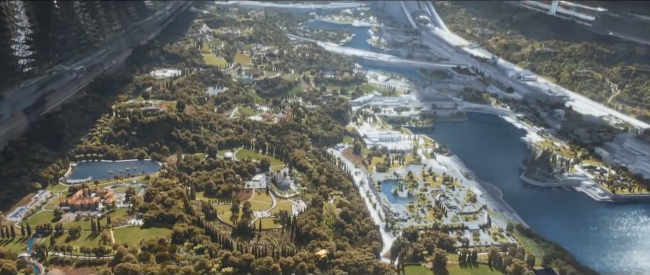
Elysium - the latest vision of a space playground for the rich and famous. Credit: Sony Pictures
"One of our slogans is that nobody stays until somebody pays," he said. "Now that could be the taxpayers so that a bunch of elite government employees can go frolic around in space or we can find customers. If it turns out that those customers begin by being Wall Street people then so be it, that'll be the start."
"You see, one of my favourite things to do with rich people is to get them to give us their money - it's very important!" he joked.
"The whole point of rich people is to have them spending their money doing things so that money goes to somebody who allowed them to do those things ... that's basic economics. If they're paying us to be able to live in a habitat in space that then creates an entire economy [then] there are people who are working in that habitat, there are things that we're learning at their expense for the development cost that we can then begin to create more and more of and lower the cost overall.
"So we may end up with some rich people going up first, but that'll be fixed over time. I think you start with the wealthy and you work your way down."
The other theory is that if it's not the rich and powerful, it will be the highly intelligent and physically fit that get all the seats on the bus to space, but Tumlinson reckons people would be surprised at the kinds of things these astronauts will have to do every day.
"You want someone on a mission who knows how to use a needle and thread as well as a computer programmer as well as a biotechnician as well as a sanitation engineer who understands how to fix toilets because these are the kinds of things you're going to encounter when you're out there," Tumlinson pointed out.
"Anything that can go wrong at your house over a weekend or a holiday is something that can happen in space and you're not going to have the nice person in the ambulance or the hardware supply store. You're going to have a lot of duct tape, you're going to take a lot of aluminium foil, different sorts of glue and all these kinds of very basic things - along with the box of needles and thread."
For the very first people that go out there, Tumlinson is willing to go even further than that - he reckons that old-age pensioners could be the first of the human race to head for the stars.
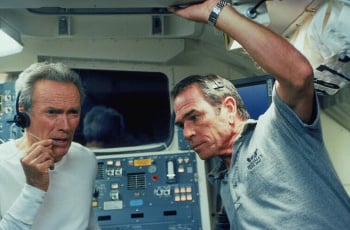
OK, Space Cowboys is a terrible movie, but it's hard to argue with
the idea of guys like these in space. Credit: Warner Bros
"Right now, what we do when somebody hits about 70 years old, we confine them into this multi-billion dollar one-way march towards death, which are senior homes and things like that and all of their usefulness to society is sucked out of them and they have nothing to do but wait for death," he said.
Tumlinson reckons this is a waste of any skilled older people who still have the physical ability to withstand a journey into space.
"Wouldn't it be interesting if we had a situation where a subset of our senior citizens were given the chance to go to a place like Mars, to be the pioneers and do the kinds of things that are required to begin preparing the way for their great-grandchildren to come and call it a new home?" he suggested.
It's a sentiment Doctor Who would likely agree with. Despite the general youth (and incidental good looks) of most of his companions, he hasn't been above taking a few different age groups aboard the Tardis. In fact, the secondary character of old-age pensioner Wilfred Mott had arguably one of the greatest impacts of any side cast member when he triggered the regeneration of the Doctor from his tenth to eleventh incarnation (The End of Time).
Travel in time is one thing but it seems us humans have got some ways to go before we've mastered that other staple of Dr. Who - getting around in space. ®